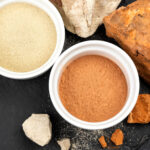Get the latest insights on price movement and trend analysis of Fatty Alcohol in different regions across the world (Asia, Europe, North America, Latin America, and the Middle East & Africa). Fatty alcohols, derived from natural fats and oils, play a pivotal role in various industrial applications, making them a significant commodity in the global market. As the demand for sustainable and bio-based products continues to rise, understanding the price trends and market dynamics of fatty alcohols is crucial for stakeholders across the value chain.
Request For Free Sample: https://www.procurementresource.com/resource-center/fatty-alcohol-price-trends/pricerequest
Definition
Fatty alcohols are a class of high molecular weight, straight-chain primary alcohols derived from natural fats and oils, primarily from plant and animal sources. They are typically saturated or unsaturated long-chain alcohols with carbon chain lengths ranging from C6 to C22. Common examples include lauryl alcohol (C12), stearyl alcohol (C18), and oleyl alcohol (C18:1).
These alcohols are produced through the hydrogenation of fatty acids or fatty acid methyl esters, which are obtained from the hydrolysis or transesterification of triglycerides. The resulting fatty alcohols are key intermediates in the production of various surfactants, lubricants, plasticizers, and other industrial chemicals.
Key Details About the Fatty Alcohol Price Trend
Global Market Overview
The global fatty alcohol market has experienced significant growth over the past few years, driven by increasing demand from various end-use industries such as personal care, detergents, and industrial applications. The market dynamics of fatty alcohols are influenced by several factors, including raw material availability, production costs, technological advancements, and regulatory frameworks.
Regional Price Trends
Asia
Asia is the largest producer and consumer of fatty alcohols, with countries like Indonesia, Malaysia, China, and India playing a dominant role. The abundant availability of palm oil, a key raw material for fatty alcohol production, has made Asia a crucial hub for fatty alcohol manufacturing. The region’s growing population and rising disposable incomes have led to increased demand for personal care and household cleaning products, further driving the market.
In recent years, the price of fatty alcohols in Asia has shown volatility due to fluctuations in palm oil prices, changes in government policies, and supply chain disruptions. For instance, the COVID-19 pandemic significantly impacted the supply chains, causing price fluctuations. However, as the region recovers and stabilizes, the prices are expected to exhibit a steady growth trajectory.
Europe
Europe is another significant market for fatty alcohols, with a strong emphasis on sustainability and bio-based products. The region’s stringent environmental regulations and consumer preference for eco-friendly products have spurred the demand for fatty alcohols derived from natural sources. Countries like Germany, the Netherlands, and the UK are key players in the European fatty alcohol market.
The prices of fatty alcohols in Europe are influenced by factors such as the availability of raw materials (like rapeseed and sunflower oil), import-export dynamics, and advancements in production technologies. The region has witnessed moderate price fluctuations, with a trend towards stability as manufacturers adapt to regulatory requirements and market demand.
North America
North America, particularly the United States, has a well-established market for fatty alcohols, driven by demand from personal care, industrial, and pharmaceutical sectors. The region’s focus on innovation and technological advancements has led to the development of efficient production processes, enhancing the market’s growth potential.
Price trends in North America are affected by factors such as raw material costs (e.g., soybean oil and tallow), energy prices, and trade policies. The recent shifts in trade dynamics and the emphasis on local production have also impacted the market, leading to moderate price fluctuations.
Latin America
Latin America, with countries like Brazil and Argentina, is an emerging market for fatty alcohols. The region’s abundant natural resources and expanding industrial base have created growth opportunities for fatty alcohol manufacturers. The demand for bio-based and sustainable products is also rising, aligning with global trends.
The price trends in Latin America are influenced by the availability of raw materials, regional economic conditions, and trade policies. As the region continues to develop its industrial infrastructure, the fatty alcohol market is expected to witness steady growth and stable pricing.
Middle East & Africa
The Middle East & Africa region is gradually gaining traction in the fatty alcohol market, driven by the growing industrial sector and increasing consumer awareness of sustainable products. The region’s strategic location and access to key raw materials like palm oil contribute to its market potential.
Price trends in this region are shaped by factors such as raw material availability, regional economic conditions, and trade dynamics. As the market develops, the prices are expected to stabilize, with a positive growth outlook.
Industrial Uses Impacting the Fatty Alcohol Price Trend
Personal Care and Cosmetics
One of the primary applications of fatty alcohols is in the personal care and cosmetics industry. Fatty alcohols are used as emollients, thickeners, and emulsifiers in various products such as lotions, creams, shampoos, and conditioners. The growing demand for natural and organic personal care products has boosted the use of fatty alcohols, influencing their price trends.
The increasing consumer preference for sustainable and bio-based ingredients has driven manufacturers to source fatty alcohols from renewable resources, impacting production costs and market prices. Additionally, innovations in formulation technologies and the introduction of new products continue to shape the demand and pricing dynamics in this sector.
Detergents and Cleaning Products
Fatty alcohols are key ingredients in the production of surfactants, which are essential components of detergents and cleaning products. The demand for effective and environmentally friendly cleaning solutions has led to the increased use of fatty alcohol-based surfactants, affecting their market prices.
The industrial and household cleaning sectors’ growth, driven by heightened hygiene awareness, has further propelled the demand for fatty alcohols. As manufacturers strive to meet regulatory standards and consumer expectations, the pricing trends are influenced by the balance between supply and demand, raw material costs, and technological advancements in production processes.
Industrial Applications
In addition to personal care and detergents, fatty alcohols find applications in various industrial sectors, including lubricants, plasticizers, and agrochemicals. The versatility of fatty alcohols in enhancing the performance and properties of industrial products has made them valuable raw materials.
The industrial applications’ impact on fatty alcohol prices is multifaceted, involving factors such as technological innovations, raw material availability, and economic conditions. For instance, the demand for bio-based lubricants and plasticizers has grown in response to environmental concerns, driving the use of fatty alcohols and influencing their market prices.
Pharmaceutical Sector
The pharmaceutical industry utilizes fatty alcohols in the formulation of various products, including ointments, creams, and drug delivery systems. The functional properties of fatty alcohols, such as their emulsifying and stabilizing capabilities, make them valuable in pharmaceutical applications.
The pharmaceutical sector’s impact on fatty alcohol prices is linked to the demand for high-purity and specialty fatty alcohols, regulatory compliance, and technological advancements in formulation processes. As the industry evolves and the demand for innovative drug formulations increases, the pricing dynamics of fatty alcohols are expected to reflect these trends.
Key Players
The global fatty alcohol market is characterized by the presence of several key players, each contributing to the market’s growth and development. These companies are engaged in the production, distribution, and innovation of fatty alcohol products, catering to diverse industrial needs.
BASF SE
BASF SE, a leading chemical company, is a prominent player in the fatty alcohol market. The company offers a wide range of fatty alcohols derived from natural sources, catering to various industries such as personal care, detergents, and industrial applications. BASF’s commitment to sustainability and innovation has positioned it as a key player in the market.
Sasol Limited
Sasol Limited, a global integrated chemicals and energy company, is another significant player in the fatty alcohol market. The company produces fatty alcohols from both petrochemical and renewable feedstocks, providing versatile solutions for different industrial applications. Sasol’s focus on technological advancements and sustainable practices has contributed to its strong market presence.
Croda International Plc
Croda International Plc, a specialty chemicals company, is renowned for its range of bio-based fatty alcohols. The company’s emphasis on sustainability and innovation has driven its growth in the fatty alcohol market. Croda’s products are widely used in personal care, home care, and industrial applications, making it a key player in the industry.
KLK OLEO
KLK OLEO, a subsidiary of Kuala Lumpur Kepong Berhad, is a leading producer of oleochemicals, including fatty alcohols. The company leverages its extensive palm oil plantations to produce high-quality fatty alcohols for various applications. KLK OLEO’s commitment to sustainable sourcing and production practices has strengthened its market position.
Emery Oleochemicals
Emery Oleochemicals, a global leader in natural-based chemicals, offers a comprehensive range of fatty alcohols derived from renewable sources. The company’s focus on innovation and sustainability has enabled it to cater to the evolving needs of industries such as personal care, detergents, and industrial applications. Emery Oleochemicals’ extensive product portfolio and commitment to environmental stewardship make it a key player in the fatty alcohol market.
Conclusion
The global fatty alcohol market is poised for continued growth, driven by increasing demand from various industrial sectors and a growing emphasis on sustainability and bio-based products. Understanding the price trends and market dynamics of fatty alcohols is essential for stakeholders to make informed decisions and capitalize on emerging opportunities.
Contact Us:
Company Name: Procurement Resource
Contact Person: Christeen Johnson
Email: sales@procurementresource.com
Toll-Free Number: USA & Canada – Phone no: +1 307 363 1045 | UK – Phone no: +44 7537 132103 | Asia-Pacific (APAC) – Phone no: +91 1203185500
Address: 30 North Gould Street, Sheridan, WY 82801, USA


